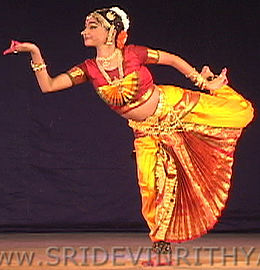Worship dance
Worship dance is any kind of dance that is undertaken for the specific purpose of religious worship.
As a basic element of human expression, dance is found within many of the world's religions, and is frequently associated with worship. However, use of the term worship dance appears to be restricted to Christianity and Messianic Judaism.
Christianity
Dance has had a chequered history within Christianity. Many records exist of prohibitions by leaders within most branches of the Christian Church, for such reasons as the association of dance with paganism, fears relating to sexuality, and a Greek-influenced belief in the separation of soul and body.
However, beginning in the latter half of the 20th century there was a significant growth in the use of dance within christian worship. This received a boost within the framework of the charismatic movement of the 1970s, which initiated a transition to contemporary worship in many churches. During this time, the International Christian Dance Fellowship was formed in Australia by Mary Jones[disambiguation needed] and it now has branches in many other countries.
Hinduism

From a Hindu point of view, the whole Universe is being brought into existence as the manifestation of the dance of the Supreme Dancer, Nataraja. In the Hindu scriptures every god has his or her own style (lasya and tandava respectively represent two aspects of dance). We read about 23 celestial beings called Apsaras who dance to please the gods and express the supreme truths in the magic of movement.
The dance in Hinduism used to be a part of a sacred temple ritual, especially in South and Eastern India, where the female priestesses devadasi's worshipped different aspects of the Divine through the elaborate language of mime and gestures. Natyashastra is the most ancient and the most elaborate scripture describing every element and aspect of this sacred art-worship.
The temple dance gradually evolved into what is known today as the South Indian Classical Dance that still preserves many ritualistic elements of Hinduism. Some of the classical Indian dancers are believed to be incarnations of apsaras.
Messianic Judaism
A distinctive style of worship dance has developed within Messianic Judaism. Known as messianic dance or davidic dance (named after King David, who famously danced before the Ark of the Covenant), it takes a similar form to Israeli Folk Dancing.
References
Christian
- Gagne, Robert, Kane, Thomas, VerEecke, Robert (1999). Introducing Dance In Christian Worship. ISBN 1-56929-030-X.
Messianic Judaism
- Silberling, Murray (1995). Dancing For Joy - A Biblical Approach To Praise And Worship, ISBN 1-880226-62-6
